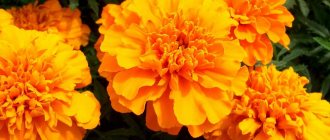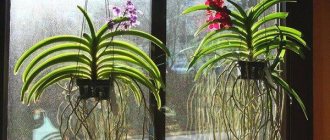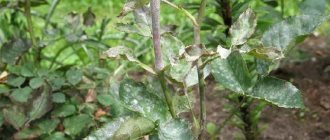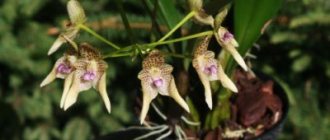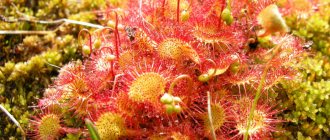Detailed description and photo
The Manhattan orchid belongs to the genus Phalaenopsis (lat. Phalaenopsis Manhatten) . She has become a favorite of many connoisseurs of indoor floriculture. It usually comes in soft pink and lilac colors with numerous speckles of a dark lilac hue, giving the flower a “marbled” appearance.
Specks tend to disappear when the flower is insufficiently illuminated and reappear with additional lighting.
The lip of the flower is bright yellow with orange hues and splashes of a darker color than the petals. The flower has a classic shape, has 3 sepals, called sepals, and 3 petals (petals), with a diameter of 8-10 cm.
Peduncles are straight, slightly inclined, 55–60 cm high, bearing up to 10–14 flowers. The flower arrow usually branches, thereby increasing the duration of the orchid's flowering.
The leaves are smooth, leathery, obovate , up to 20 cm long. In good lighting, just like on the flower, specks of a darker shade are noticeable. Typically, an adult plant has 3 to 6 leaves.
A characteristic feature of the orchid root system is the presence of aerial roots covered with a layer of velamen. With proper care, the Manhattan orchid usually has such roots that are well developed and cope with the task of providing the plant with a sufficient amount of moisture.
Synonyms[edit | edit code]
- Phalaenopsis schilleriana f. immaculata (Rchb.f.) Christenson 2001
- Phalaenopsis schilleriana var compacta nana Hort. 1890
- Phalaenopsis schilleriana var delicata Dean 1877
- Phalaenopsis schilleriana var grandiflora Van Brero 1935
- Phalaenopsis schilleriana var. immaculata Rchb.f. 1875
- Phalaenopsis schilleriana var major JD Hook ex Rolfe 1886
- Phalaenopsis schilleriana var odorata Van Brero 1935
- Phalaenopsis schilleriana var pallida Val & Tiu 1984
- Phalaenopsis schilleriana var purpurea O'Brien 1892
- Phalaenopsis schilleriana var splendens Warn. 1878
- Phalaenopsis schilleriana var viridi-maculata Ducharte 1862
- Phalaenopsis curnowiana Hort. 1891
How is it different from other types?
First of all, the genus Phalaenopsis, to which the Manhattan orchid belongs, is distinguished from other types of orchids by the following characteristics:
- Short stem and wide leathery leaves.
- Aerial roots covered with a layer of velamen.
- Peduncles, as well as aerial roots, grow in special axils between the leaves.
- They grow only upward, usually branching.
- The flowers resemble butterflies, hence the name of the genus.
The difference between the Manhattan variety and other phalaenopsis varieties is:
- The presence of specks of a darker color on the surface of the entire flower, which can disappear with a lack of light.
- The flowers are light pink and light lilac.
- Bright yellow with hints of orange and speckles.
- Lack of aroma.
Useful video
Below is an informative video about the Manhattan orchid:
In separate materials on our site you can learn about other, no less interesting types of orchids. Read about the beautiful Cattleya, lush-flowering Vanda, thin-leaved Miltonia, graceful Cambria, elite Beauty, extraordinary Brassia, charming Sogo, luxurious Multiflora, mysterious Bulbophyllum and sunny Mini Mark.
Bloom
The flowering period of the Manhattan orchid is quite long and can last all year.
When and how does it bloom?
With sufficient lighting and a comfortable temperature, an orchid can throw out several branching flower arrows. Their sequential flowering can continue throughout the year, but in winter additional lighting will be required. However, more often in winter there is a short period of rest.
On the peduncle there are up to 14 flowers of delicate light pink and light lilac color , covered with small inclusions darker than the main color.
What do the fruits look like?
The fruit of an orchid is a capsule with 3-6 valves, in which up to 1 million tiny dust-like seeds can ripen.
Reviews
Larisa. “Quite by accident I found an orchid that someone had thrown away. Fortunately, several roots turned out to be green. I nursed and nurtured her for about a year. And finally, my beauty got stronger and began to grow. It bloomed for the first time in the spring. I looked for its name in catalogs for a long time and was so glad that it was Phalaenopsis Manhattan, which I had long dreamed of purchasing to add to my 15 hybrid species. Beautiful orchid!”
Tatiana. “I purchased Phalaenopsis Manhattan from a flower shop in 2015. Only its appearance is not similar to what is in the pictures on the Internet. The leaves are without specks and the color is a little off. I talked a lot on forums and the shortcomings in care were explained to me. It turned out that the problem was with the lack of lighting. I added an additional one, I’ll wait for the result.”
Olesya. “I grow 6 types of phalaenopsis, but Manhattan pleases with its beauty. In general, I love pink colors, but this one is so delicate and blooms for quite a long time. I haven't experienced any problems at all in three years. Three flower stalks bloom for almost 7 months.”
Planting material and its cost
Orchid planting material (babies, cuttings) are rarely on sale; they usually sell a ready-made plant . Occasionally can be seen for sale on the Internet.
Planting material at home can be obtained from an adult plant. Under favorable conditions, orchid roots can produce babies. Sometimes such babies (keiki) can grow on a peduncle. Within six months, they grow leaves and roots. When the roots of the baby reach a length of 5-6 cm, it can be transplanted into a separate pot.
Reproduction
Many growers propagate orchids by children without making any effort and without stimulating kidney hormones.
For the Manhattan orchid, propagation by rhizomes is unacceptable . In nature, this type of orchid reproduces by seeds, and after flowering by the appearance of new young shoots.
The dried rosette of an adult orchid should be divided into two halves and the part with one or two roots should be cut off. A "stump" that remains until new buds appear, which are then cut off from the mother plant. If the plant is healthy, then vegetative propagation can be carried out. All operations must be performed using sterile instruments.
What should the soil be like?
The soil for growing an orchid must contain:
- Tree bark. It is best to use pine bark, which must be thoroughly boiled and calcined to kill pests.
- Charcoal.
- Moss, it is best to use sphagnum.
- Drainage layer. To create it, you can use polystyrene foam, expanded clay, perlite, vermiculite, and coconut chips.
Step-by-step instruction
How to plant correctly:
- Prepare the pot and fill it 2/3 full with substrate.
- Using a sharp knife, carefully cut the baby from the mother plant. Half an hour later, after the cut area has dried, sprinkle it with charcoal or lubricate it with brilliant green.
- Place the plant in the pot, holding it by the neck, spreading the roots over the surface of the soil.
- Sprinkle with the remaining soil so that the root system is located above the edge of the pot. The soil should not be compacted.
- Watering should be done after a few days.
Transplant technology
There are several reasons for transporting a plant to a new place of residence:
- overgrown root system;
- overcompaction and unsuitability of the substrate.
It is not often necessary to replant the Manhattan variety; for good growth, it is enough to carry out the procedure once every 3 years, after the flowering stage.
Transplant chronology:
- The plant is carefully removed from the pot.
- Place in water, soak,
- Carefully inspect the roots. Remove damaged, overdried segments. The cut site is treated with crushed activated carbon.
- Dry it.
- At the bottom of the container, make a layer 2 cm thick of inert materials, then lay the bark, which is moistened with a spray bottle.
- The epiphyte is installed without deepening the neck. Fill the space with the remaining substrate. In dry indoor microclimates, the surface is mulched with sphagnum. Over the next 3 days you must refrain from watering.
Caring for a plant at home
Caring for the plant is not difficult; it is necessary to maintain optimal conditions for growth and flowering.
- Temperature . The comfort temperature for the Manhattan orchid is 22-25 degrees; in winter, 18-20 is allowed.
- Lighting . The plant should be in a well-lit place, but direct sunlight should be avoided. In winter, to maintain flowering, illumination with a phytolamp is recommended.
- Watering . Watering should be done once a week in summer, and once every 10-14 days in winter. Under no circumstances should the flower be over-watered. It is best to place the pot in a deep tray with settled water at room temperature for 20-30 minutes. You can spray the plant without allowing drops of water to fall on the flower or leaves.
- Feeding . For feeding, you should use special fertilizers for orchids, which can be found in flower shops. Fertilize after watering, on moist soil, so as not to burn the roots with chemicals.
- Trimming . It is recommended to trim the peduncle after flowering only if it dries out. If the arrow does not dry out after flowering, it may bloom again. If it does not occur for a long time, the arrow is cut 1.5 cm above the dormant bud.
- Transplant . It is not advisable to replant an orchid often. It is better to do this if the root system has grown too much and requires replanting into a larger pot. You also need to replant the plant if the soil becomes unusable.
- Care during the flowering period . During the flowering period, no additional care is required. Maintaining optimal temperature, sufficient lighting, timely moistening and fertilizing will allow the orchid to bloom for a long time.
Common mistakes when growing
It is not uncommon for new gardeners to have an orchid that does not take root. The reason lies in the lack of knowledge about the requirements of the variety, as well as in the neglect of basic care criteria.
Leads to death:
- Excess moisture. Despite the fact that phalaenopsis feels uncomfortable during prolonged drought, it is not recommended to over-water the plant. In addition, the flower needs air rather than soil moisture.
- Too much sun. It is worth considering that epiphyte under natural conditions grows in the shade of trees. Therefore, when placing it on a southern window sill, you should stick a frosted film on the glass or hang blinds.
- Frequent replanting, required only as the substrate “wears out”.
- Watering time. The best option is in the morning, so that the soil has time to dry out by night.
Diseases and pests
Orchid diseases, like human diseases, are divided into viral, fungal and bacterial. To treat flower diseases, it is most often necessary to cut out the diseased area with a sharp sterile instrument, capturing healthy tissue.
The cut area must be treated with brilliant green or iodine and sprinkled with crushed coal. To treat specific diseases, special commercially available drugs are used.
Flowers can also be damaged by pests, which most often infect orchids from neighboring plants, unsterile soil, or by purchasing a flower infested with pests in a store.
Major pests:
- thrips;
- nematodes;
- mealybug;
- spider mite;
- aphid;
- scale insects;
- woodlice;
- idiots.
For effective pest control, the following drugs are used: Aktara, Actellik, Fitoverm, Agravertin. Use according to the instructions on the package.
Prevention of various problems
Preventing problems when growing Manhattan orchids includes the following measures::
- Careful inspection and treatment of the plant after purchase.
- Periodic preventive treatment with the biological product "Fitoverm".
- Fulfilling the requirements for keeping an orchid: temperature conditions, timely watering, ventilation without drafts.
As we can see, caring for a Manhattan orchid is actually not a very labor-intensive task and following simple rules for maintaining a flower does not take much time. But elegant, delicate flowers can delight you for a long time.
